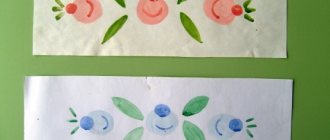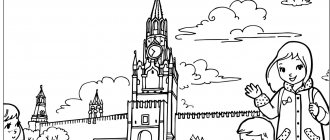Preview:
Municipal autonomous preschool educational institution
Combined kindergarten "Ryabinushka"
continuous educational activities
Educational field "Artistic and aesthetic development"
Learn to depict in a drawing various houses and buildings located on one side of the street.
Strengthen technical skills and abilities.
Exercise your ability to independently choose means of expression, using traditional and non-traditional methods of painting.
Learn beautifully, select (combine) a color palette when painting.
Learn to place the image over the entire surface of the sheet, determining the location of individual objects.
Educational field "Cognitive development"
Expand children's knowledge about the variety of materials from which houses are built.
Lesson summary “My Street” (middle group)
Elena Chaus
Lesson summary “My Street” (middle group)
Goal: to cultivate in children a love and a sense of pride for their street , their hometown.
• consolidate children's knowledge of the concept of “ street ”
, knowledge of one’s address and the address of the kindergarten, the ability to talk about
the street on which the child lives (NGO “Social and Communicative Development”
, NGO
“Cognitive Development”
, NGO
“Speech Development”
);
• continue to introduce your hometown and its attractions (NGO “Social and Communicative Development”
, NGO
“Cognitive Development”
, NGO
“Speech Development”
, NGO
“Artistic and Aesthetic Development”
);
• activate vocabulary, cognitive interest (NGO “Speech Development”
, NGO
“Cognitive Development”
);
• attract children’s attention to this topic with the help of modern computer technologies (NGO “Cognitive Development”
);
• develop speech, observation, attention, memory, thinking, perception (NGO “Speech Development”
, NGO
“Social and Communicative Development”
, NGO
“Cognitive Development”
);
• develop gross motor skills (NGO “Physical Development”
);
• cultivate love for one’s hometown, street , home, the desire to see them beautiful and clean (NGO “Social and Communicative Development”
, NGO
"Artistic and Aesthetic Development"
).
Preliminary work: conversations about home address, visiting a store, mail, the difference between school and kindergarten; educational games “Find two identical houses”
,
“Where is your home”
, “What is extra
(school supplies)
”,
“Who lives where”
;
role-playing games “Drivers”
,
“Shop”
,
“Kindergarten”
,
“Mail”
;
reading poems by S. Drozhzhin “
Walking the Street ” , S. Marshak
“Mail”
;
guessing riddles about transport; drawing your street (together with parents)
.
Drawing “My native street”
nailya gribanova
Drawing “My native street”
Drawing with children of the senior , preparatory subgroups on the topic “ My native street ”
Goal: to create conditions for improving the skill of depicting high-rise buildings and various types of transport
Learn to depict in a drawing various houses and buildings located on one side of the street .
Strengthen technical skills and abilities.
Exercise your ability to independently choose means of expression, using traditional and non-traditional methods of painting.
Teach beautifully, select (combine)
color palette when painting.
Learn to place the image over the entire surface of the sheet, determining the location of individual objects.
1. Thick sheets of A4 size drawing .
4. Colored pencils.
5. Photos depicting the street of the village of Arbaty and the main attractions.
Integration; Communication; Work; Health; Music.
LESSON 23. How to draw a city street
Welcome to my blog, aspiring artist!
In the last lesson on drawing a room from frontal perspective, you practiced the skill of creating a single vault point in the center of the drawing. Let's take this idea further and draw part of the city in frontal perspective , where buildings, sidewalks, roads are located and seem to dissolve into one point in the distance.
Take another look at the drawing of the city.
Looks very interesting, right? This is true! And drawing it is much easier than it seems. We will devote this lesson to strengthening a number of drawing principles: size, location, shading, as well as proportions, additional details and practice.
In drawing, the term "perspective" stands for "creating the illusion of depth on flat surfaces." The word "perspective" comes from the Latin word spec, meaning "to see."
1. Draw a horizontal line with an anchor point in the center.
2. Just as you drew guide lines to determine the position of the ceiling, walls and floor in the previous lesson, draw these lines to determine the location of buildings and the road.
3. Draw a vertical line where the buildings begin. Start on the left side. Then draw a vertical line where the buildings end, also on the left side. Make sure the lines are strictly vertical and parallel to the edges of your notebook. You can use a ruler if you want. When I draw a small frontal illustration, I usually don't use anything, I do it by hand. Try to draw this way and that, both with a ruler and by hand. Which method did you like best?
Get 10 free video lessons
Ten free video lessons from the Kalacheva School drawing school are available immediately after registration.
Using promo code REFPART
— 10% discount on all courses with teacher verification until the end of 2021!
Get
When you draw with a ruler, the drawing will be uncompromising and precise, whereas drawing by hand will not look as precise, but will reflect your personal style. It often happens that someone who begins to experiment with the triangle becomes dependent on this tool. It should be understood that a ruler is just another drawing tool, just like shading. However, you can draw perfectly well without them.
4. Now do the same on the right side. Draw vertical lines to indicate the position of the buildings.
5. Make sure the top and bottom edges of the buildings meet at the center vault point.
6. Draw horizontal lines corresponding to the horizon line from the top and bottom corners of each building on the left side of the drawing. This is the moment when your drawing becomes three-dimensional!
7. Now do the same on the right side of the drawing.
8. Draw the road and median. Shade the building shapes. Place the light source at the point of the arch and shade all surfaces facing the opposite direction.
LESSON 23: PRACTICAL TASK
In life, you yourself, without knowing it, encounter a frontal perspective . For example, when you cross the street or while shopping in a supermarket, you notice a neatly lined island of cans. It's really very exciting. ABOUT! Another great place for a frontal perspective is the library! All the books on the shelves are in neat rows. Pay attention to this the next time you're at the supermarket or library. This makes the idea of frontal perspective crystal clear!
Redraw the lesson again and add a few additional details. You can draw doors, windows, neighbors... Have fun! Draw canopies, a porch, perhaps a flower pot or two. True details are the spice of life!
LESSON 23: PRACTICAL TASK No. 2
Why stop there? Why not use the frontal perspective technique in reality and see how it works? Take your easel and go outside. Find a location that is visually interesting. Try to sit somewhere in a park, on a bench, on a pier... And repeat what you see.
You can also take a suitable photo and use it. Of course, this is not as interesting as walking, but it will still help you practice frontal perspective .
Here is one inspiring example:
Share your works in the VKontakte group in this album!
Link to next lesson!
Materials from the book “You can draw in 30 days” by Mark Kistler were used.
Book in Russian by Mark Kistler “You will be able to draw in 30 days.”
Drawing ideas for every day









